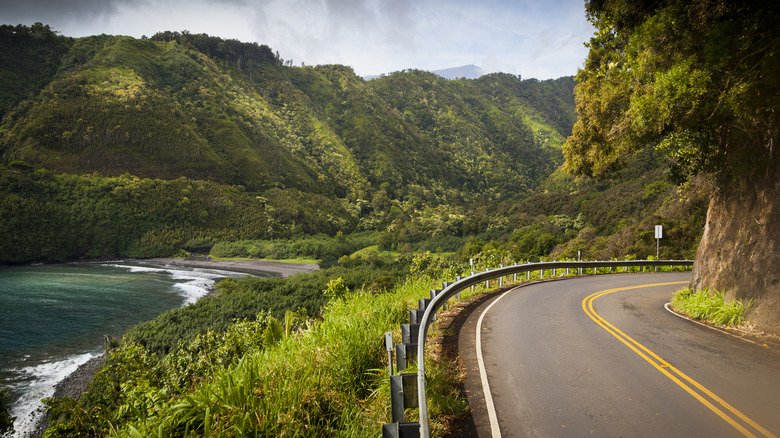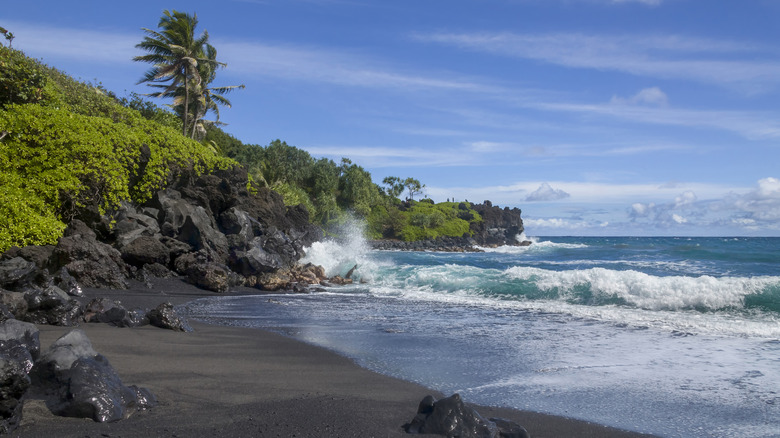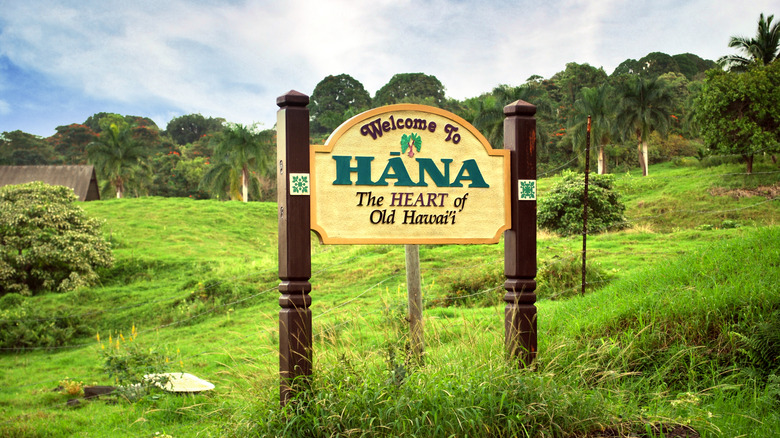Road To Hana: The Safest Time For Maui's Most Scenic Drive
For many of us, a trip to Hawaii would be enough itself. Incredible food, lazing on the beach, a singular culture you can't experience anywhere else stateside. But for a certain segment of traveler, a bit more romance (and maybe some thrills) are a prerequisite to a memorable getaway. To them, we humbly suggest Maui's famous road to Hana.
Let's start with the basics, per the Hawaii Guide: 50 one-way bridges? Check. More than 600 turns? Double check. But don't forget the potential for rock-slides or mud-slides. And all of this on just 52 miles of road. So, given all that, you might be inclined to wonder why anyone would travel the road in the first place. Nevertheless, thousands do every year — and if the word-of-mouth recommendations aren't enough to entice you, then the photos just might.
Thankfully, there are a number of steps you can take (including simply being a passenger and letting a professional driver do the work!) to ensure you have a safe and memorable trip on this Hawaiian gem.
Tricky but not impossible
You've not doubt heard the idiom about experiences being more about the journey than the destination and, while we can't guarantee that for things like getting braces or going to college, it's certainly true in this case. While the trip may be challenging, it is packed with jaw-dropping beauty you may only see this once, so a strategy is critical to building the best possible trip.
Hawaii Guide cautions that motion-sickness can be a major issue here, so a little self-assessment of your own tolerance for bumps and jumps before the drive is recommended. That said, if you're committed, you also need to be an early riser. The road gets quite congested and even starting off on your journey at 7 a.m. is considered late. Why? Well, it partly has to do with the care it takes to drive the road, and it partly has to do with the number of folks who want to travel it. But it's also due to the number of stops you'll be making (remember what we said about the journey vs. the destination?). Expect to be pulling over frequently — and admittedly, clumps of haphazardly parked cars can be an indication of a good sight to see — but be mindful of local laws concerning where and when you can stop.
An early start is essential but what about time of year? Fall months tend to be the off-season in Maui, as tourists return to the mainland for school and the holiday season. If your schedule is a bit flexible, you could be rewarded with an easier trip along this gorgeous route.
So what can you see?
Road to Hana lists a number of must-see stops along the way, including Ho'okipa Lookout, which offers stunning cliffside views and a beach park but a word of caution that these massive waves are for experienced surfers only.
Twin Falls in the Ho'olawa Valley is another great stop. Road to Hana notes that the falls are located near Wailele Farm, an eco-friendly farm committed to sustainable practices which also offers recreational access in addition to a welcoming farm stand. The lower falls are close to the entrance. The upper Caveman Falls is about three-quarters of a mile down a gravel road.
At the easternmost tip of Maui is the town of Hana itself, plus Hana Bay Beach Park and Kaihalulu Beach. Just outside of town is the red-sand Koki Beach, which Tour Maui says was made by a nearby volcano. In the distance, visitors will likely be able to see Alau Island, a 5-acre sanctuary for seabirds.
Driving the road to Hana is one surefire way to experience a bit of authentic Hawaii since it remains largely undeveloped compared to much of the island. And that may just be reason enough for an early bedtime and some Dramamine.


